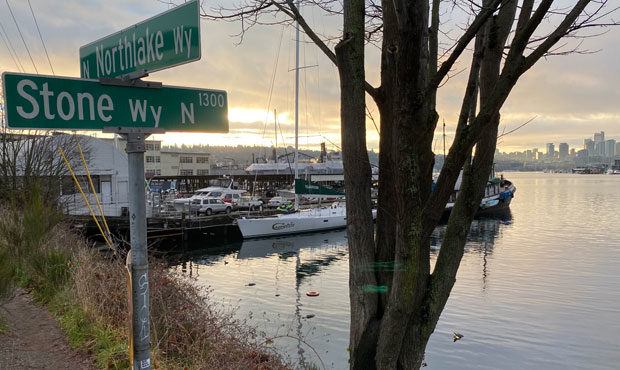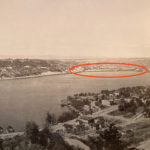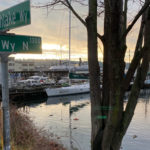All Over The Map: Ghosts of Seattle’s long-forgotten Stone Avenue Bridge
Jan 8, 2021, 9:42 AM | Updated: 11:08 am
Puget Sound is a region of bridges. Some are very old, and some have been refurbished or replaced. Some have sunk or been knocked down by the wind – or simply doomed by bad design. Just over a century ago, one bridge crossed Lake Union for only six years before it was demolished and then never rebuilt.
Given the strife caused by the ailing West Seattle Bridge, the long process to replace the 520 floating bridge, and even the relief that the Salmon Bay Bridge will be preserved – it’s stating the obvious to say that bridges have been – and still are – essential in Western Washington.
Though nobody remembers it now and very few people have even heard of it, the late, great Stone Avenue Bridge carried wagons, cars, pedestrians, and streetcars across Lake Union for less than a decade before disappearing into the mists of history forever.
The idea of connecting Puget Sound to Lake Union and Lake Washington goes back to the 1850s, and by the late 19th century, a canal had been dug between Salmon Bay and Lake Union. To get across the canal, there were rudimentary bridges built at either end in Ballard and Fremont.
By 1910, federally-funded work was getting underway to improve the canal as part of the project that would eventually include the Ballard Locks, and to fill in large sections of boggy lakeshore land along Westlake Avenue to get ready for a new and improved Fremont Bridge. So, the old Fremont Avenue bridge – which carried wagons and cars and street cars – had to close to traffic for long stretches, and a temporary bridge was then needed to keep traffic moving during the construction and re-shaping of the landscape.
Merchants in the Green Lake commercial district wanted the temporary bridge to cross from Westlake Avenue just north of Halladay Street – near where modern marinas now line the shore – and connect to Stone Avenue, which even then was sometimes called Stone Way. This route for the bridge, which is about 12 blocks east of Fremont Avenue and the bridge it would temporarily replace, would allow street cars to take a direct route northbound on Stone – and shave as many 10 minutes off the commute from downtown to Green Lake by not having to transfer through Fremont.
Fremont merchants, not surprisingly, wanted the bridge to cross the water closer to them for obvious reasons.
The battle to choose a site for the new bridge raged throughout much of 1910. Various associations were formed or energized to support the potential routes, and there was even a big public rally with thousands of people at Woodland Park. When the rally was over and the various groups had stated their preferences, the route from Westlake at Halladay across Lake Union to Stone was ultimately selected.
Construction of the mostly wooden structure got underway late in 1910, and the temporary bridge – which was 2,700 feet long and was wide enough to include two lanes for cars, wagons, two street car tracks down the middle, and a sidewalk on either side — opened on May 31, 1911. The bridge itself stood out on the Lake Union landscape, and the structure was clearly visible from the north end of Capitol Hill.
The Stone Avenue Bridge included a fairly sizable junction on the north end of the bridge on Stone Avenue, right around what’s now North 34th Street and North 35th Street. This spot is right on the border of the Wallingford and Fremont neighborhoods, about a half block from where the city dump (officially, the North Transfer Station) stands.
It’s unclear exactly what the junction included besides a waiting area for streetcar passengers – perhaps a trestle and various ramps for traffic headed north to Green Lake, and west to Fremont, and east toward the University District. Photos of the north end of the bridge are hard to come by.
What seems unusual is that the structure was a “fixed bridge” – that is, not a drawbridge. Thus, no ships with tall masts were able to get into or out of Lake Union once it was built, though there was an 80-foot wide span at the north end that allowed for vessels less than 25 feet tall to pass.
For six years, the Stone Avenue Bridge did its job of getting all kinds of traffic back and forth across Lake Union, which became especially critical when the old Fremont Avenue Bridge was washed out by a flood in March 1914.
Once the modern Fremont Bridge opened in June 1917 – the same one that, with a major renovation a decade ago, still stands – the Stone Avenue Bridge had done its job. Within a few days, demolition began in order to open up the lake and the Lake Washington Ship Canal route to taller vessels, and ensuring that the dream of connecting salt and fresh water would come to full fruition.
If there’s anything left of the old Stone Avenue Bridge, SDOT says that might include remnants of old pilings in the lake bed. Otherwise, there’s no visible evidence of what was once a pretty massive – and massively important – structure.
You can hear Feliks every Wednesday and Friday morning on Seattle’s Morning News and read more from him here. If you have a story idea, please email Feliks here.


















